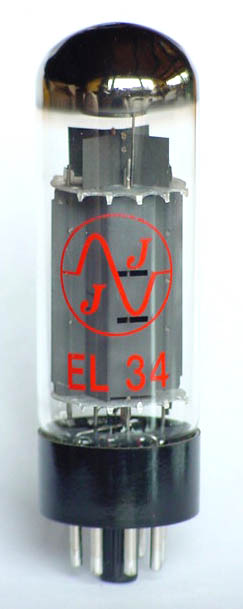Tubes
Guitarists Bands Lesson Plans Techniques Gear Theory Genres GMC Journal GMC Instructors Student Instructors All portals
Contents |
History
Vacuum tube, electron tube, or thermionic valve; it is the simple device which has driven modern music since the early 1900's. Tubes (short) saw mainstream use in radios and signal amplification as early as the 1920's. By the 1950's they were in every major juke box across America.
In the 60's the tube guitar amplifier gained much fame, and even though it has been replaced in most of the industries it saw use in, it is still the amplification device of choice for most modern electric guitarists and bassists.
Types
The Tube Amplifier comes in many varieties. Different wiring classes and power requirements have created a wide range of tubes to meet the many sounds the industry requires. But, for the most part, tube amplifiers operate on the same two basic principles. Pre-amplification and amplification each requiring a different type of tube to produce a different effect.
Preamp Tubes
Preamp tubes are required for the pre-amplification section of a vacuum amplifier. They provide tonal characteristics which are distinct to each type of preamp tube. They also provide an abundant amount of what is known as "gain" or "saturation". The term "saturation" comes from the electron plate inside the tube being saturated with electrons and dissipating them causing a loss of signal which in turn creates distortion in the final sound. This latter effect is what most guitar players equate to being the most important part of the preamp section or gain stage. The most common preamp tube is the 12AX7.
Power Tubes
Power tubes are wired into guitars to boost the signal before sending it to the loudspeaker. Many guitar players incorrectly assume that power tubes are not important to the tone of the amp since they see them as signal boosters only. This misperception is due mainly to the fact that many players believe distortion (attributed mainly to preamp tubes) is part of the amps tone and power tubes all have the same sound.
However, many professional guitarists will note than an amplifier driven by 6L6 power tubes sounds characteristically different than an amplifier driven by EL34's regardless of the amplifier manufacturer. The tonal center of the amplifier can be overdriven to provide the fullest amount of saturation. But, many beginner and amateur guitarists don't realize this because that requires the amp to be played at maximum or near maximum volume and can approach the human threshold for pain making it quite uncomfortable to listen to in a small room such as a bedroom or garage.
Care
A vacuum tube consists of arrangements of electrodes in a vacuum within an insulating, temperature-resistant envelope. The vacuum shell is made of glass thus making a tube somewhat delicate. While in use a vacuum tube can become extremely hot and glow red, orange, or yellow. This is when a tube is at it's most fragile state. An amp should never be moved, carried, or jostled while the tubes are hot. If the amp must be moved around the stage while it is on or while the tubes are still hot it should be moved carefully using both hands or even with two people. Many players add wheels to the cabinet to provide smoother moving around the stage.
Tubes function most efficiently while hot so many modern amps have the ability to allow the tubes to warm up prior to having a signal applied. This is achieved using a separate standby switch in addition to the power switch. To extend the life of tubes in an amplifier it is always best to let the amp standby for a few minutes before turning the power fully on. Also, many players recommend slowly increasing the volume to the desired level to allow for slower thermal expansion rates of the tube's components.
Never block the back of the amplifier head or cabinet with any objects or by placing it too close to a wall. Although tubes run most efficiently hot they CAN overheat if proper ventilation is not allowed. The interior components will literally melt if allowed to overheat. Read the owners manual for manufacturers specific recommendations.
Do not touch the glass tubes with your skin or fingers. If you do wipe them clean with a dry oil free cloth prior to using. Even the trace amount of oil present in a fingerprint can create a heatsink on the surface of the glass allowing that portion to superheat (become hotter than normal) and crack or shatter. This phenomenon is present with halogen bulbs as well but most players will express that amplifier tubes are not nearly as sensitive.
Replacement
Related GMC Lessons
No related lessons at this time.
Relate Articles
Sources
(external links recommended)






